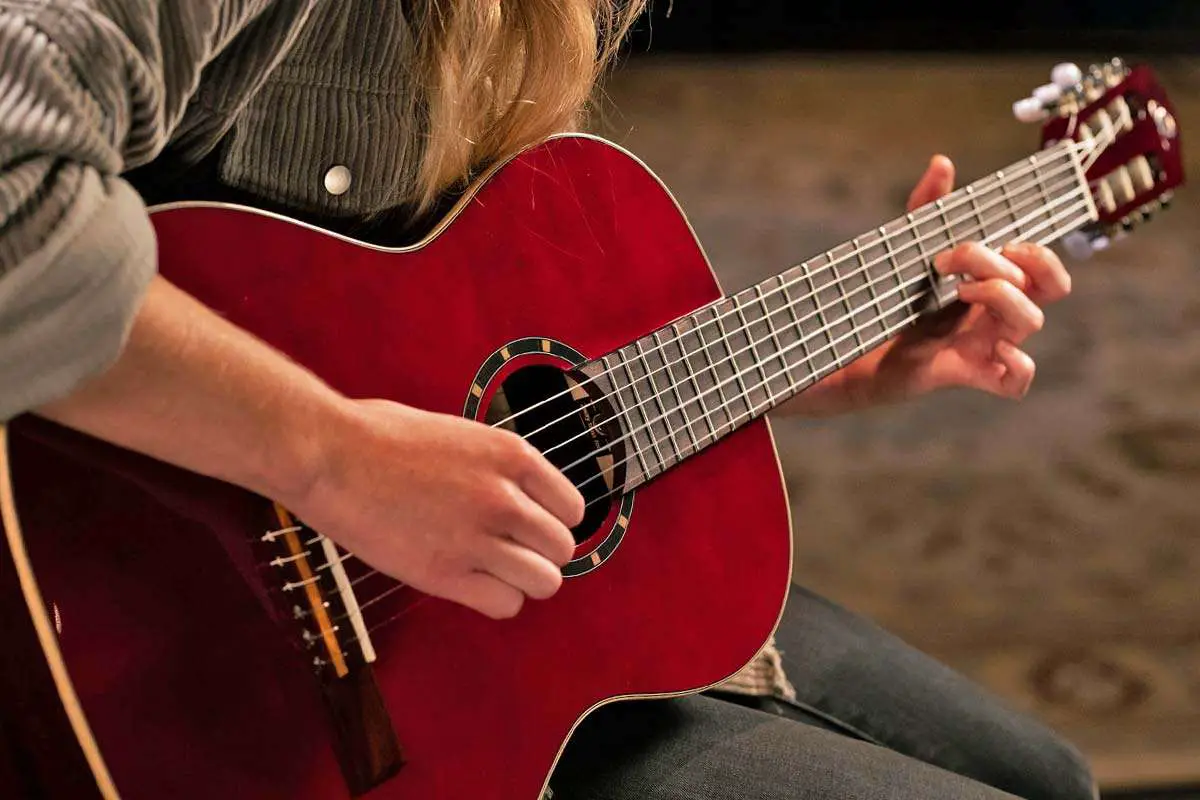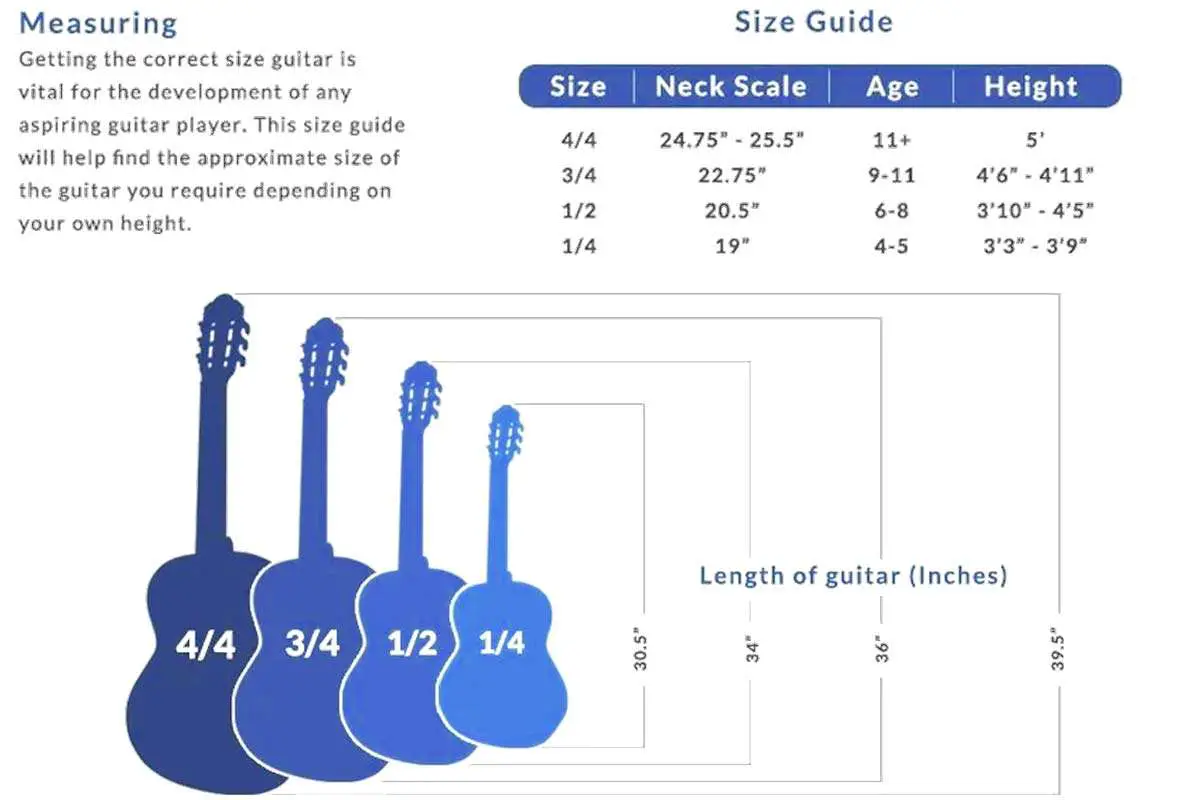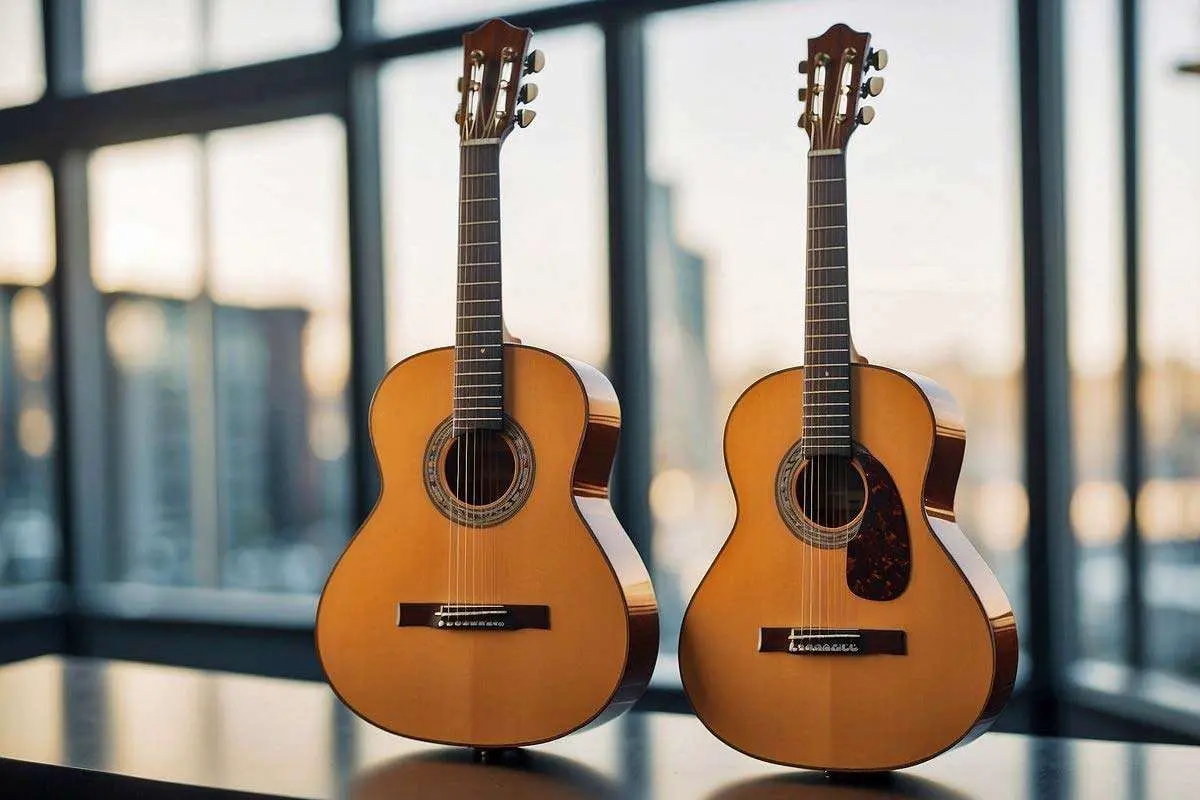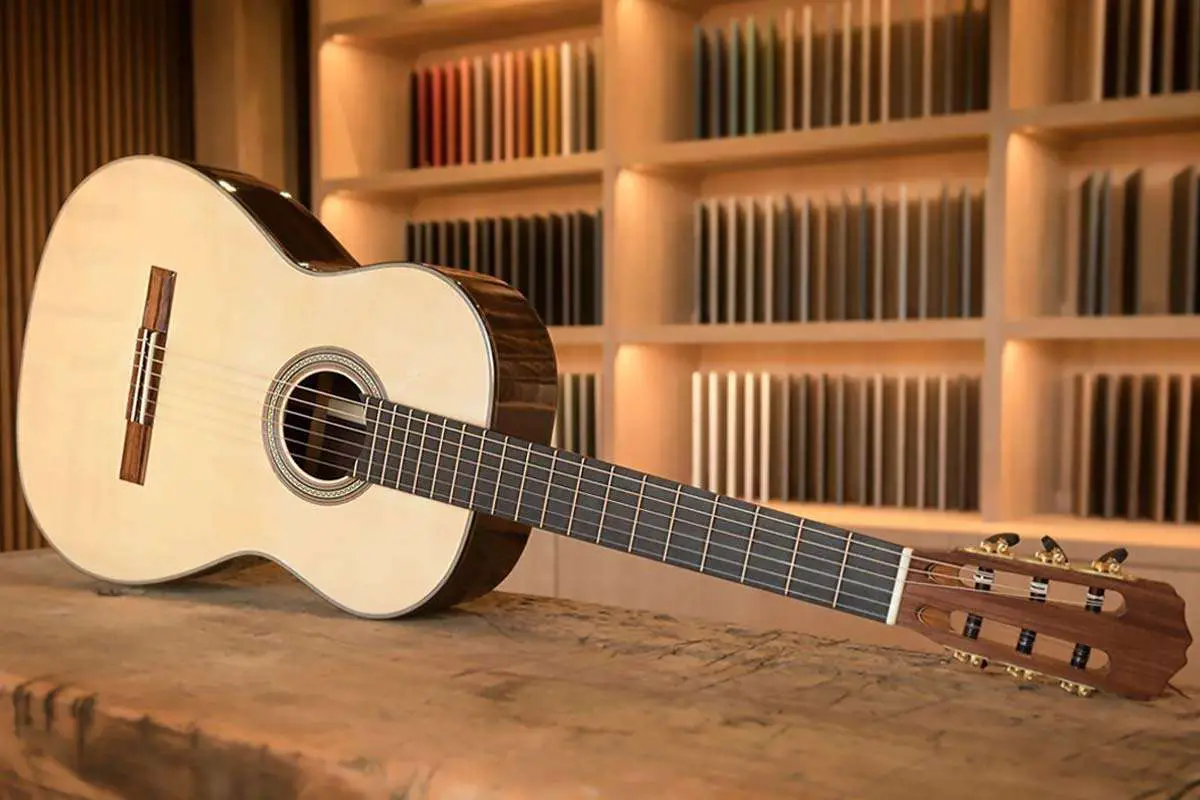For aspiring guitarists and those with smaller hands, understanding 3/4 classical guitar dimensions is essential in choosing the right instrument to begin or continue their musical journey. These scaled-down guitars offer a perfect balance between full-bodied sound and manageable size, typically featuring a scale length of 22.8 to 24.2 inches.
The compact body and narrower neck of a 3/4 size classical guitar facilitate easier access to all frets and more comfortable navigation of the fretboard, making it an ideal choice for younger players or those with a smaller physique. While catering to comfort, these instruments maintain impressive sound quality, serving as an excellent stepping stone before transitioning to a full-size guitar.
Whether you’re a beginner or an experienced player looking for a more manageable instrument, understanding the nuances of 3/4 classical guitar dimensions can significantly impact your playing experience and musical development.
Key Takeaways:
- A 3/4 size classical guitar typically has a scale length of 580 to 615 mm (22.8 to 24.2 inches), ideal for younger players or those with smaller hands.
- The body dimensions are proportionally smaller than full-size instruments, with a lower bout width around 368 mm (14.5 inches) and shallower depth for improved comfort.
- The nut width is narrower than full-size models, resulting in closer string spacing that better suits smaller hands.
- These guitars feature nylon strings and reduced string tension, enhancing playability and reducing strain for beginners.
- When selecting a 3/4 classical guitar, consider the player’s size, acoustic vs. electric preferences, build quality, and price points ranging from under $250 for beginners to over $500 for high-quality instruments.
Realted: Best Strings For Classical Guitars

Understanding Guitar Sizes
In this section, you’ll gain a clear understanding of the various dimensions of guitars across different sizes and why scale length is crucial, particularly when evaluating 3/4, 1/2, and 7/8 size guitars, including the unique aspects of 3/4 size classical guitars.
Related: The Difference Between Acoustic & Classical Guitars
The Spectrum of Guitar Sizes
Guitars come in varying sizes to accommodate players of all ages and physical statures. The full-size guitar, often referred to as a 4/4, is the standard size for adults. Typically, electric guitars have a standard size, while acoustic guitars, including classical models, offer a range of sizes—1/4, 1/2, 3/4, 7/8, and full-size.
Scale Length and Its Importance
Scale length is the distance from the nut to the saddle of a guitar, directly influencing the tension, feel, and tonal qualities of the instrument. A longer scale length produces more tension, leading to a brighter tone, while a shorter scale length results in a warmer sound, which is essential to consider when selecting a guitar.
Navigating 3/4, 1/2, and 7/8 Size Guitars
When choosing a guitar, particularly for children or individuals with smaller frames, it’s crucial to understand the differences in sizes. A 1/2 size guitar is typically suited for young children, while a 3/4 size guitar is often the choice for older children or adults looking for a more compact instrument. The 7/8 size guitar is nearly a full-size and can be a comfortable option for adults seeking a slightly smaller instrument.
The Unique Characteristics of 3/4 Size Classical Guitars
A 3/4 size classical guitar typically has a scale length ranging from 580 to 615 mm (22.8-24.2 in), making it conducive for players who find full-size models unwieldy. Its manageable size maintains the sound quality of a classical guitar while providing ease of playability, particularly for younger musicians or those with a smaller reach.
Design and Dimensions of 3/4 Classical Guitars
Understanding the design and dimensions of 3/4 size classical guitars will help you make an informed decision when considering one for a younger player or for travel convenience.

Body Dimensions and Shape
The body of a 3/4 size classical guitar typically has a neck scale length ranging from 577 to 615 mm (22.75-24.2 inches). You’ll find that the body depth is shallower compared to full-size classical guitars, which makes it more comfortable for smaller players to handle. Manufacturers carefully craft the body shape to achieve a sound that is as close as possible to its full-size counterparts. Here’s a look at common measurements:
- Lower bout width: around 368 mm
- Upper bout width: often proportionally smaller
- Waist: typically narrower for ease of playing
Neck Proportions and Nut Width
The neck of a 3/4 size guitar is designed for playability, ensuring that you can comfortably reach all frets without overextending your hand. The nut width—less than the standard 52 mm found on full-size models—fits smaller hands perfectly. The reduced nut width also means narrower string spacing, which suits younger players or those with smaller fingers.
Total Length and Weight Considerations
When it comes to total length, expect a 3/4 size classical guitar to be considerably shorter than the standard 100 cm (39.4 inches) of a full-size guitar. This reduction in size translates to a lighter instrument; your 3/4 classical guitar will typically weigh less, enhancing portability and reducing the strain of holding and maneuvering the instrument during practice sessions or performances. The overall length is an important aspect of the guitar that contributes directly to its playability and portability.
3/4 Classical Guitar Features for Enhanced Playability
When considering a 3/4 size classical guitar, your comfort and ease of playing are largely influenced by its design and string setup. These guitars are tailored to provide a more approachable experience, especially for younger players or those with smaller hands.

Nylon Strings and String Tension
Nylon strings are known for their softer feel under your fingertips, making them ideal for long practice sessions. The string tension in a 3/4 classical guitar is lower compared to a full-size guitar, which further eases the playability for beginners or younger musicians. This reduced tension allows you to fret notes and form chords with less effort, thus encouraging proper technique without unnecessary strain.
- String Type: Nylon, for ease of play
- Tension: Reduced, compared to full-sized guitars
Fret Accessibility and Fingerboard Design
The frets on a 3/4 classical guitar are closer together, thanks to the shorter scale length, typically ranging from 580 to 615 mm. This makes it easier for you to reach across the fingerboard and execute complex finger movements. A well-designed fingerboard should feel comfortable under your hand, allowing for smoother transitions between notes and chords.
- Scale Length: Approximately 580 to 615 mm
- Fingerboard: Scaled for easier access to all frets
The Role of the Headstock and Tuning Machines
The headstock and tuning machines play a critical role in maintaining the stability and playability of your guitar. On 3/4 classical guitar dimensions, the headstock is proportionally sized to balance the instrument, further enhancing comfort. Meanwhile, quality tuners ensure that your guitar holds its tuning reliably, allowing you to focus on your playing rather than constantly adjusting the pitch.
Selecting a 3/4 Classical Guitar for Specific Needs
When choosing a 3/4 classical guitar, it’s important to consider who will be playing it and the environment in which it will be used. Specific features such as size, acoustic versus electric capabilities, and the quality of the materials directly impact the playability and sounds you can achieve.
Related: Top 67 Songs For Acoustic Guitars
The Best Guitars for Children and Small Hands
For children or individuals with small hands, the ergonomics of 3/4 classical guitar dimensions are crucial. A guitar like the Yamaha CGS103A with its 585mm (23″) scale length offers great comfort. The reduced distance between the frets allows easier access to chords and notes, which is essential for encouraging practice and reducing strain.
Comparing Acoustic and Electric Models
When evaluating 3/4 guitars, consider the differences between acoustic and electric models. A 3/4 acoustic classical guitar typically provides a rich, warm sound and is solely acoustic in nature. On the other hand, an electric model, while rare in classical design, lets you amplify your music and experiment with sound effects, which might be engaging for some young players.
Evaluating Materials and Build Quality
The materials used in a guitar influence both its sound and durability. For 3/4 classical guitars, a spruce top is often praised for its bright, vibrant tone, while mahogany back and sides contribute to a full, rich sound. Inspect the construction quality as well—solid joins and a well-finished body not only extend the instrument’s lifespan but also ensure consistent sound.
Brands and Models of 3/4 Classical Guitars
When you’re looking for a smaller-sized classical guitar, several trusted brands offer a range of 3/4 models designed to suit different playing styles and budgets. Whether you’re a beginner or an experienced player in need of a compact instrument, there’s a variety of brands and models to explore.

Popular Brands Like Yamaha and Fender
Yamaha is known for its quality craftsmanship and consistency across its range of instruments. One notable 3/4 model is the Yamaha CGS103A Classical Guitar, which offers a comfortable playing experience with its 23″ scale length. This guitar is a favorite among music teachers for younger students.
Fender also provides you with reliable choices when it comes to 3/4 classical guitars. Their models are often designed for ease of playability, making them suitable for players of all levels who require a smaller instrument.
High-Value Options: Cordoba Cadete and Others
For a balance of affordability and quality, consider the Cordoba Cadete. This guitar doesn’t just deliver on price, but it’s also crafted with attention to detail and sound quality. With a slightly longer scale length of 615mm, it can be a versatile choice for both young learners and players looking for a compact nylon-string travel guitar.
Other brands offer similarly high-value options in the 3/4 size market. These models aim to blend playability, sound quality, and affordability, catering to a broad audience looking for an accessible entry point into classical guitar music.
Luxury Choices for the Discerning Player
When your preferences lean towards more luxury choices, several guitar brands cater to this market with premium materials and detailed craftsmanship. While specific models may vary, luxury 3/4 classical guitars are typically made with finer woods and offer superior sound and playability. These instruments are often sought after by professional musicians and serious enthusiasts who demand the best in terms of tone and build quality.
Making the Purchase: Price Points and Buying Advice
When purchasing a 3/4 size classical guitar, approach price points with a clear budget in mind, and be ready to evaluate offers carefully. Be sure to consider where to buy for the best experience, and don’t overlook the importance of warranty and return policies for peace of mind.

Setting a Budget and Evaluating Offers
Before you start shopping for a 3/4 classical guitar, determine your budget. It’s crucial to decide on a spending limit and stick to it. 3/4 guitars can range from affordable options suitable for beginners, to higher-priced models for more serious young musicians. Evaluate offers based on factors like build quality, materials used, and included accessories. Align these features with what you’re willing to spend.
- Under $250: Generally, beginner models, lower in build and sound quality.
- $250 – $500: Good quality for serious students, often comes with necessary accessories.
- $500 and above: High-quality options, better craftsmanship, made of superior woods, and more likely to hold their value.
Where to Buy: Store vs. Online Shopping
You have two main options for purchasing your guitar: in-store or online.
In-store:
- Pros: You can try before you buy, get professional advice, and avoid shipping risks.
- Cons: May have a higher price tag due to overhead costs.
Online:
- Pros: More options, potential for better deals, and shop from the comfort of your home.
- Cons: Can’t try before you buy, the risk of damage during shipping.
